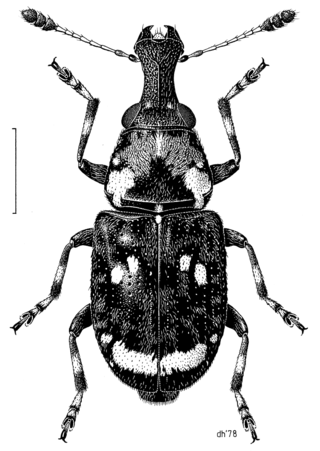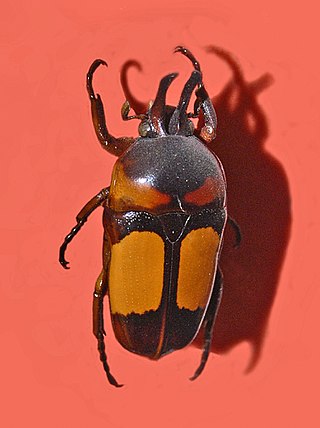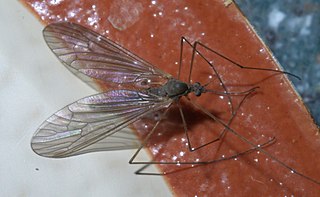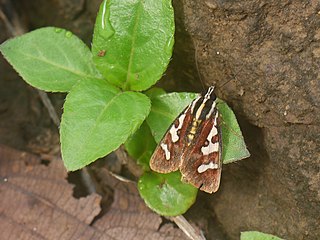
The Integrated Taxonomic Information System (ITIS) is an American partnership of federal agencies designed to provide consistent and reliable information on the taxonomy of biological species. ITIS was originally formed in 1996 as an interagency group within the US federal government, involving several US federal agencies, and has now become an international body, with Canadian and Mexican government agencies participating. The database draws from a large community of taxonomic experts. Primary content staff are housed at the Smithsonian National Museum of Natural History and IT services are provided by a US Geological Survey facility in Denver. The primary focus of ITIS is North American species, but many biological groups exist worldwide and ITIS collaborates with other agencies to increase its global coverage.

Anthocoridae is a family of bugs, commonly called minute pirate bugs or flower bugs. Worldwide there are 500-600 species.

Cryptophagidae is a family of beetles with representatives found in all biogeographic realms. Members of this family are commonly called silken fungus beetles and both adults and larvae appear to feed exclusively on fungi although in a wide variety of habitats and situations, such as rotting wood and shed animal fur and feathers. These beetles vary from about 1 to 11 millimeters long, and usually have an oval body shape with a slight "waist".

Anthribidae is a family of beetles also known as fungus weevils. The antennae are not elbowed, may occasionally be longer than the body and thread-like, and can be the longest of any members of Curculionoidea. As in the Nemonychidae, the labrum appears as a separate segment to the clypeus, and the maxillary palps are long and projecting.
The Catalogue of Life is an online database that provides an index of known species of animals, plants, fungi, and microorganisms. It was created in 2001 as a partnership between the global Species 2000 and the American Integrated Taxonomic Information System. The Catalogue is used by research scientists, citizen scientists, educators, and policy makers. The Catalogue is also used by the Biodiversity Heritage Library, the Barcode of Life Data System, Encyclopedia of Life, and the Global Biodiversity Information Facility. The Catalogue currently compiles data from 165 peer-reviewed taxonomic databases that are maintained by specialist institutions around the world. As of September 2022, the COL Checklist lists 2,067,951 of the world's 2.2m extant species known to taxonomists on the planet at present time.

Myopsocidae is a family of mouse-like barklice, belonging to the infraorder Psocetae of the order Psocodea. This family is closely related to Psocidae, with which it shares similar wing-venation, but from which it is distinguished by three-segmented tarsi.

Clivina is a genus of ground beetle native to the Palearctic, the Nearctic, the Near East and North Africa. There are more than 600 described species in Clivina.

The Euphyes is genus of North American butterfly of the family Hesperiidae (skippers), subfamily Hesperiinae.

Lixus is a genus of true weevils in the beetle family Curculionidae, raised by the Danish entomologist, Johan Christian Fabricius in 1775. There are at least 950 described species in Lixus.

Euphyes bimacula, the two-spotted skipper, is a butterfly of the family Hesperiidae. It is found in North America, from northeast Colorado and western Nebraska; eastern Nebraska east to southern Quebec; southern Maine south to central Virginia; coastal plain south to Georgia; and the Gulf Coast.

Periscelididae is a family of flies.

Dicheros is a genus of beetles belonging to the family Scarabaeidae, subfamily Cetoniinae.

Carex trichocarpa, the hairy-fruited sedge, is a species of Carex native to North America. It is listed as a "species of special concern" in Connecticut, the United States. The larvae of Euphyes bimacula, the two-spotted skipper, feed on the plant. Euphyes bimacula is listed as endangered in Connecticut.

Trichocera is a genus of winter crane flies in the family Trichoceridae. There are more than 140 described species in Trichocera.
Cyrtopogon bimacula is a species of robber flies in the family Asilidae.
Trichocera garretti is a species of winter crane flies in the family Trichoceridae.

Aegocera bimacula is a moth of the family Noctuidae first described by Francis Walker in 1854. It is found in India and Sri Lanka.

The twospot hawkfish, or twinspot hawkfish, is a species of marine ray-finned fish, a hawkfish belonging to the family Cirrhitidae. it is found in the Indo-Pacific. It can be found in the aquarium trade.

Trichocera maculipennis, commonly known as the winged winter cranefly, is a species of winter crane fly, of the order Diptera. First described by German entomologist Johann Wilhelm Meigen in 1818.
















